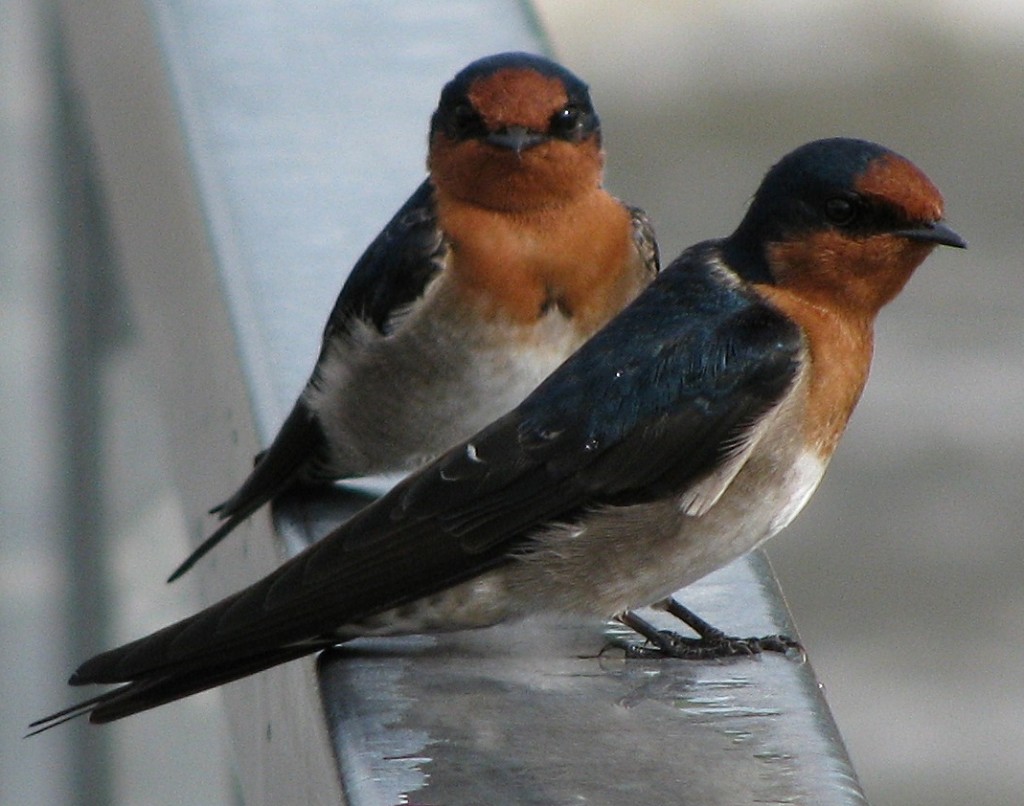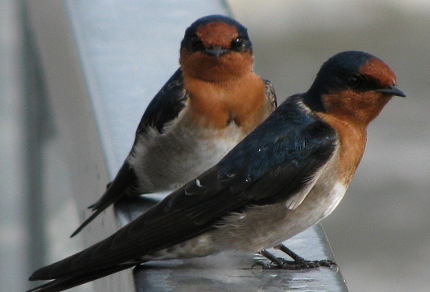
Welcome Swallows, Hirundo neoxena, at Aplin’s Weir, Townsville (© Vilis Nams)
Given the chance to be a bird, I would choose the incredible speed, agility, and grace of a swallow, preferably one of the species with a glistening blue-black back and long, forked tail. Australia’s welcome swallow would fit the bill. I’ve observed this darting, swooping insect-devourer on countless occasions in Townsville’s Ross River Parkway, where it skims over lawns and the river in pursuit of prey. Like other members of the avian family Hirundinidae, the welcome swallow is adapted to securing its food on the wing with swift, acrobatic flights. Common and familiar throughout much of Australia, with the exception of the driest deserts and northern Western Australia and Northern Territory, the welcome swallow is also known as the Australian or house swallow.1
Australia is home to four species of native swallows – the welcome and white-backed swallows and tree and fairy martins – and is visited by three migratory, non-breeding species in summer – the barn, red-rumped, and Pacific swallows, with the Pacific swallow rarely reaching these shores.2 Within this group of seven, the martins are readily distinguishable from the swallows by their shorter tails lacking the long, elegant outer feathers characteristic of swallows.2 To date, I’ve seen all of the native swallows and martins, but none of the migratory ones.
During the first half of our year in Australia, I was sometimes unsure if the particular acrobatic insect-hunter I was observing was one of the swallows and martins or a swift, swiftlet, or woodswallow, the latter three completely unrelated to swallows and martins. Howerver, with more experience, I learned that swifts and swiftlets possess much longer and more pointed wings in proportion to their body size than do the Hirundinids,3 and that woodswallows possess squared-off, unforked tails and shorter, thicker wings.4

Fairy Martin Nests near Wiluna, Western Australia (© Vilis Nams)
Welcome swallows tend to hunt low, while tree and fairy martins often hunt higher in the air, frequently in mixed flocks.3 In Townsville, tree martins commonly perch on wires by Ross Creek and hunt high overhead, their dark backs and heads standing out in sharp contrast to their dirty white rumps. Fairy martins, with their clean, white rumps and cinnamon caps, are regular hunters above the wetlands of the Townsville Town Common Conservation Park, and I’ve observed them in mixed flocks with tree martins at Ross Dam and Shelley Beach. The dramatically-patterned white-backed swallow doesn’t occur in the north of Australia, but I did observe several of these swallows flying about at a cliff face at Diamond Head in Hat Head National Park, New South Wales, in 2001.
On our recent desert trip to the Alice Springs area, Vilis and I saw flocks of fairy martins wheeling and swooping beside the fiery-red rock walls of Trephina Gorge, on which the martins had constructed mud-pellet bottle nests. Australia’s other native Hirundinids create equally intriguing nests, the welcome swallow building a grass-bound, mud-pellet cup on the undersides of bridges and eaves of buildings, the tree martin hiding its grass and leaf nest in a hollow tree or cliff hole, and the white-backed swallow digging a 30 to 100-centimetre-long tunnel in road cuts or creek banks and then laying its eggs on a thin lining of leaves within the tunnel.5 Today, Vilis and I noticed a number of welcome swallows under the Bowen Road bridge, fluttering around the metal support beams. Perhaps they were choosing nest sites.
Note that I’ve just published an Aussie exploration post for September 21 – The Burke and Wills Expedition. This is called plugging the holes while moving forward.

Fairy Martin Nesting Habitat, Trephina Gorge, Northern Territory (© Vilis Nams)
Reference:
1. Graham Pizzey and Frank Knight. The Field Guide to the Birds of Australia. 1997. Angus & Robertson, Sydney, p. 502.
2. Ibid, pp. 502-505; 3. Ibid, pp. 313, 315; 4. Ibid, pp. 457, 459; 5. Ibid, pp. 502, 504.


